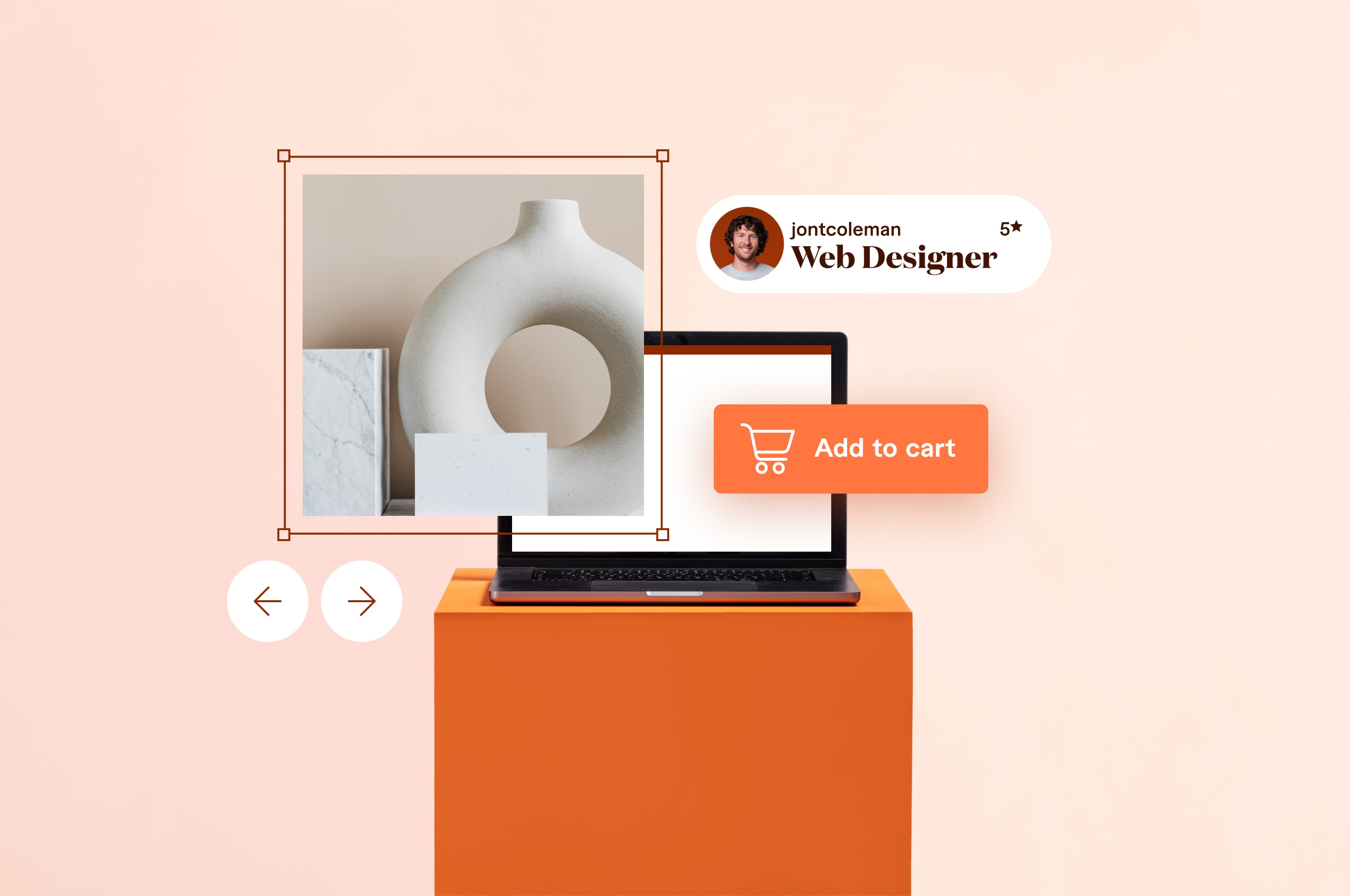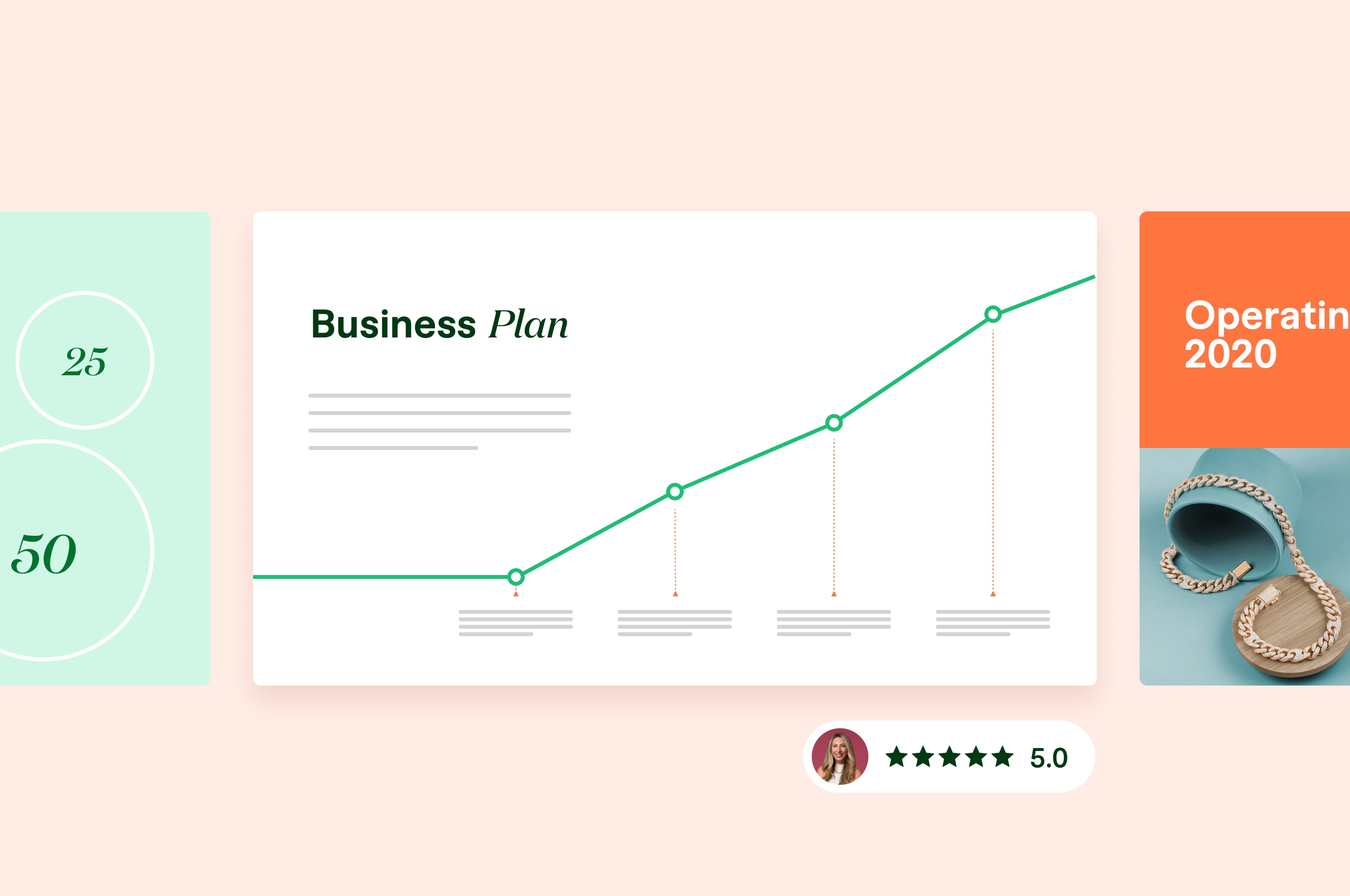Ecommerce 101: What It Is, Benefits, and How to Get Started
Ecommerce, short for electronic commerce, refers to buying and selling goods or services over the internet. In this guide, you’ll learn more about the industry and what it entails.
 July 1, 2024
July 1, 2024 26 minute reading
26 minute reading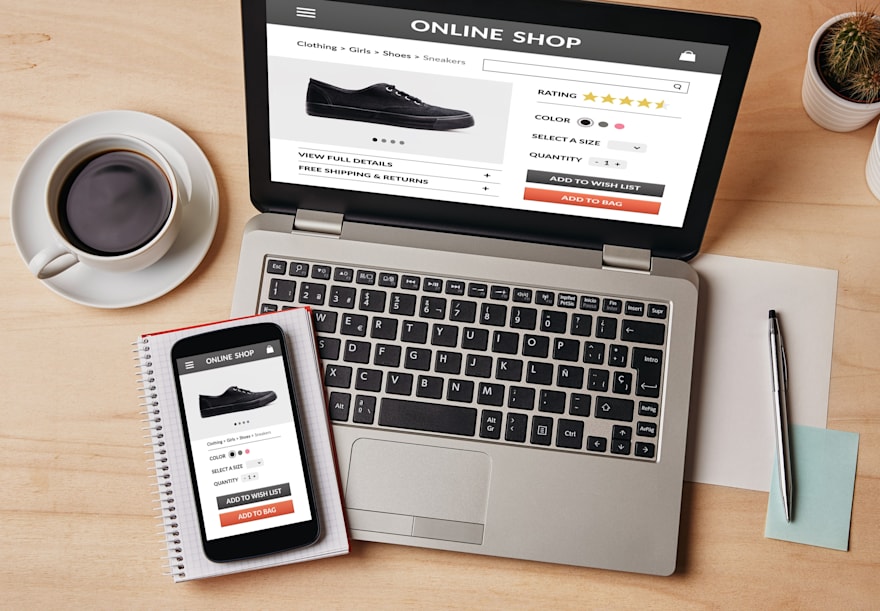
In 1994, Dan Kohn created NetMarket, the "equivalent of a shopping mall in cyberspace." That's where the first ecommerce transaction took place—Kohn sold a Sting CD, "Ten Summoner's Tales," to a friend in Philadelphia for $14.28 plus shipping. It marked the world's first secure online purchase.
Thirty years later, ecommerce has become a norm in the business world, growing at a rate of 9.47% each year, and expecting a market volume of $5 trillion by 2029.
The convenience and accessibility of online shopping fueled its growth while posing an accessible opportunity for business owners. Brands can sell their products and services online without investing resources in a physical storefront.
In this guide, we’ll explore the intricacies of the ecommerce industry and how you can set up a successful business.
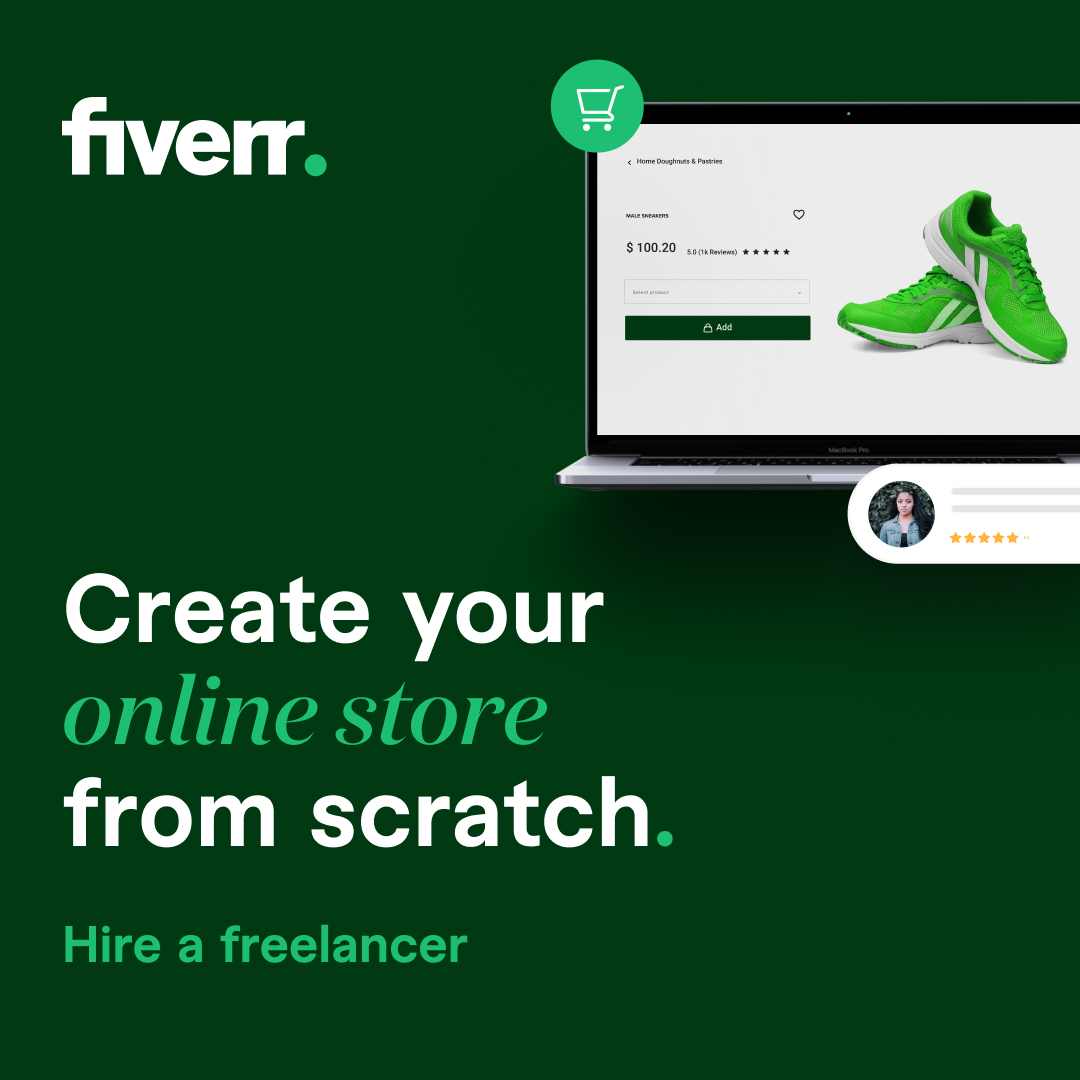
Need to understand the fundamentals of ecommerce? Keep reading.
Ready to start selling? Find Ecommerce development services by freelance developers on Fiverr.
Start sellingWhat is ecommerce?
Ecommerce, short for electronic commerce, refers to buying and selling goods or services over the internet.
It includes the following:
Online transactions
Retail sales
Wholesale purchases
Digital products/services
It’s not a traditional retail sale that relies on physical stores or auctions to sell products.
Ecommerce giants like Amazon, Alibaba, and eBay have popularized online commerce. We can attribute this to factors like increased internet penetration globally, the proliferation of mobile devices, and growing trust in online stores and payment systems, so much so that the average revenue per user is expected to be $1387 by 2029.
And this isn’t limited to the giants. Even your local brick-and-mortar store can create an ecommerce website to reach a broader pool of customers. It shows how it’s ushered in a new way to do business—no matter where your business is.
How does ecommerce work?
If you've ever bought anything online, you've participated in ecommerce. Although those transactions may seem seamless and straightforward, they involve many processes in every order.
Here’s what the typical ecommerce transaction looks like:
You submit an order on your favorite ecommerce retailer’s website.
The website’s server sends your order to the company’s order management system (OMS).
The OMS checks with the inventory management system to see if the item is in stock.
If it's stock, the order gets processed by the company. If not, it sends a request to order more supplies.
The stock database then transmits your order to the merchant system run by a credit card processing firm or bank.
Once the systems confirm the purchase, you'll receive an order confirmation notice.
The OMS sends the order details to the vendor's warehouse management system and requests them to process it.
The warehouse ships your order via in-house or third-party logistics partners.
Elements of an ecommerce store
The lifecycle of one order goes through multiple systems—making the order a physical reality. These systems are an ecommerce store's core elements, including the following.
Inventory management
This system tracks and controls product stock levels to ensure the right items are available when customers want to purchase them. It helps avoid stockouts and overstocking, which hurts your business and disappoints customers.
They set up alerts for low stock levels and automatically update inventory as and when orders come in. IBM and Zoho are examples of commonly used inventory management systems.
Order management
An OMS automatically sends order confirmations to customers, updates inventory levels, and generates shipping labels. These tools also handle returns and exchanges, issue refunds, and communicate with customers about order status.
You integrate it on your website's backend and let it automate these processes. Some examples include Brightpearl, Shopify, and Quickbooks Enterprise.
Payment processors
These processors let your customers pay securely via encrypted platforms. While you can offer cash-on-delivery options, offering online payments enables you to process orders confidently and improve cash flow.
They handle the complex tasks of:
Verifying customer information
Processing credit card payments
Transferring funds to your account
Refunding customers when required
PayPal, Stripe, and Square are popular payment processors that ecommerce businesses use.
Supply chain management
This process involves coordinating all activities related to the movement of goods from the manufacturer to the end customer. The goal is to ensure the customer receives the order within the prescribed timeline.
So, choose reliable carriers like FedEx, UPS, or USPS—and appropriate shipping methods based on factors like:
Product size
Weight
Destination
Product quantity
PII storage and security
Personally Identifiable Information (PII) refers to any customer data that can identify an individual. For example, data like:
Name
Address
Email
Phone number
Credit card information
You must adhere to security standards and privacy regulations as you store data for thousands of customers.
Privacy regulations, such as the General Data Protection Regulation (GDPR) in the European Union and the California Consumer Privacy Act (CCPA) in the United States, set strict requirements for this purpose. Failure to comply could cause data breaches and legal liabilities.
What are the 10 types of ecommerce models?
There are several types of ecommerce business models. Here are the most common>
1. B2B ecommerce
Business-to-business (B2B) ecommerce refers to the online transactions between two businesses. For example, if you’re a manufacturer selling to a wholesaler or a wholesaler selling to a retailer.
Example: Alibaba.com connects manufacturers, wholesalers, and distributors with buyers worldwide. It lets buyers purchase products in bulk and request customized orders.
2. B2C ecommerce
Business-to-consumer (B2C) ecommerce involves businesses selling products or services directly to individual consumers through online channels.
It’s the most common model and includes industries like beauty and cosmetics, household goods, and electronics.
Example: Amazon, an ecommerce marketplace, offers millions of products to customers worldwide. You can make purchases via your phone, tablet, or desktop computer—without reaching out to individual sellers.
3. C2B ecommerce
Consumer-to-business (C2B) ecommerce is a model where individuals offer their products or services to businesses.
In this model, consumers create value for businesses, and businesses pay for the provided goods or services.
Example: Shutterstock, a stock photo provider, lets businesses and individuals access copyrighted photos through individual licenses. It allows creators to monetize their skills while businesses access a diverse talent pool.
4. C2C ecommerce
Consumer-to-consumer (C2C) ecommerce involves transactions between individual consumers facilitated by an online marketplace or platform.
In this model, consumers sell products or services directly to other consumers, and the e-commerce platform acts as an intermediary. The platform provides a space for listings, communication, and payment processing.
Example: Etsy is an online marketplace that lets individuals sell handmade, vintage, and unique goods to buyers worldwide. The difference is that you can directly communicate with the seller and even customize items.
5. C2VB ecommerce
Consumer-to-virtual-business (C2VB) ecommerce is a relatively new model that involves transactions between individual consumers and virtual businesses.
Virtual businesses operate entirely online without a physical presence. In this model, consumers purchase digital products or services from virtual companies.
Example: Udemy, an e-learning platform, lets individual instructors create and sell online courses on various subjects to consumers worldwide. The instructors act as virtual businesses—offering licensed content through the platform.
6. B2G ecommerce
Business-to-government (B2G) ecommerce refers to the online transactions between businesses and government agencies.
Businesses sell products or services to government entities through online channels.
Example: GSA Advantage is an online marketplace that lets government agencies purchase products and services from pre-approved businesses. It improves the procurement process by connecting relevant vendors with the right agencies—opposed to asking hundreds of companies to submit a tender.
7. C2G ecommerce
Consumer-to-government (C2G) ecommerce involves transactions between individual consumers and government agencies.
Consumers can access government services, pay taxes, or purchase government-issued products online.
Example: The U.S. Department of the Treasury's platform, TreasuryDirect, lets individuals buy, manage, and redeem U.S. Treasury securities, such as savings bonds and Treasury bills.
8. G2B ecommerce
Government-to-business (G2B) ecommerce refers to the online transactions between government agencies and businesses. Government agencies provide services, information, or products to businesses through online channels.
Example: U.S. Small Business Administration's (SBA) SBA.gov platform offers a range of resources for growing a small business. For instance, they offer loan programs, grants, and training materials to get started.
9. G2C ecommerce
Government-to-consumer (G2C) e-commerce involves transactions between government agencies and individual consumers. Unlike G2B, in this case, the government offers services to citizens.
Example: U.S. National Park Service's (NPS) Recreation.gov platform offers resources to browse, plan, and book trips to recreational facilities (national parks and campgrounds).
10. DTC ecommerce
Direct-to-consumer (DTC) ecommerce models allow companies to sell their products directly to customers—with no intermediaries.
Unlike those who sell via third-party providers, they have complete control over their brand, marketing, ecommerce sales, and distribution channels.
Example: Warby Parker, an eyewear company, manufactures and sells its line of affordable glasses through its website and select retail locations. Customers can even try them for free at home, with the option to exchange or return purchased glasses.
Where do ecommerce transactions take place?
While you may shop from a website or a mobile app, there’s a distinction between the type of website it is. Here’s a list of places where ecommerce transactions take place.
Online marketplaces
Marketplaces connect buyers and sellers—via a centralized platform to conduct transactions. They list products from sellers, giving buyers a suite of products.
For example, eBay lists products from different sellers and facilitates the transaction within the platform.

eBay’s marketplace
Ecommerce platforms
These platforms are software solutions that allow you to create and manage online stores.
An excellent example of this is Shopify, which offers the tools and features to showcase your products and manage your business's backend. Whether you want to create a website or market your business, the platform offers a lot of possibilities.

Shopify’s website homepage
Social selling channels
These channels have ushered in a new type of commerce called social commerce. It refers to the use of social media platforms for ecommerce transactions.
For example, Instagram's Shop feature lets you enlist your product directly on the platform and facilitate transactions there. You can also tag products in your posts and stores, driving more traffic to your in-app store.
Mobile-based apps or websites (m-commerce)
If you're making an ecommerce transaction via a mobile app, it's called an m-commerce transaction (mobile commerce). Consumers use their mobile devices more often than other devices. According to Pew Research Center, 76% of U.S. adults use their smartphones to make a purchase.

For example, ASOS, a popular fashion retailer, developed an app that allows customers to browse, search, and purchase products easily on their mobile devices. Its customers can now receive personalized recommendations and offers for promotions without going into another channel like email.
Enterprise websites
These websites focus on large-scale businesses with complex operations. For instance, they’d need a feature-heavy platform that lets them manage all their operations in one place.
For example, SAP Commerce Cloud or Oracle Commerce is built to handle a high volume of transactions and manage your inventory for you.

SAP’s Commerce Cloud. SAP
What are the benefits of ecommerce?
Here are some reasons ecommerce has increased in popularity:
Convenience
Your customers no longer have to walk into a store or wait for a new store to open in their location. They can visit your website or app and begin experiencing your brand.
It's an excellent option for people with busy schedules, limited mobility, or who live far from shopping centers. Saved shopping carts and wishlists make it easy for customers to keep track of products they're interested in and purchase them later.
Wider product selection
Online stores don't have physical limitations like shelf space or store size. They can carry a vast inventory of products from multiple brands and categories. Also, you can find unique or hard-to-find items with relative ease.
Personalization
With the amount of data ecommerce stores have, it’s relatively easy to personalize the shopping experience if done well. It’s become a bare minimum standard these days.
That’s why many brands go that route. An Algolia report found that 33% of decision-makers plan to implement product recommendations based on search or purchase history. While that’s one way to do it, as you dig more into your data, there will be many other opportunities to do the same.
Efficiency
Your customers can access features like one-click ordering, saved payment and shipping information, and express shipping options. It makes the entire process easier for them and you as a business owner.
You can automate these processes on your backend and focus on the things that matter the most—like the quality of your product or customer service.
How many ecommerce revenue models exist?
There’s no one-size-fits-all approach to building an ecommerce company. Here are a few ways you can do it.
Retail stores
One of the most common revenue models involves selling products directly to consumers at a markup. Retailers purchase products from manufacturers or wholesalers and sell them at a higher price to make a profit.
For example, if you purchase a shoe from a wholesaler for $20, you sell it to the consumer at $25—leading to a $5 profit. Of course, you need to consider the margin and cost of doing business, but this shows what's possible.
Wholesale
In this case, businesses sell products in bulk quantities to other businesses at a discounted price. Then, a retailer sells it at a higher price.
For example, you can sell clothing goods in bulk at a discounted price to a retailer. However, you need to account for sourcing, manufacturing, and advertising costs.
Dropshipping
In dropshipping, ecommerce businesses sell products without holding inventory. When a customer orders, the business purchases the product from a third-party supplier, that then ships it directly to the customer.
For example, Oberlo integrates with Shopify to allow entrepreneurs to quickly add products to their online stores and ship them directly to customers.
Crowdfunding
You can raise money from many people to fund a project or product development. You can use these platforms to pre-sell products or offer rewards to backers.
For example, in 2015, Pebble Time, the smartwatch company, raised over $20 million on Kickstarter to fund the manufacturing and distribution process. Over 78,000 people offered funds to receive the product.
Subscription
Subscription commerce involves customers paying a recurring fee to access a product or service. You can offer access to:
Subscription boxes
Exclusive content
Exclusive offers
Consideration of product feedback
For example, Dollar Shave Club delivers razors and grooming products to customers monthly for a flat fee.
Service
Here, you can sell services rather than a physical product. You can do this via a marketplace like Fiverr or by setting up and promoting your own website.
For instance, many service providers, such as ecommerce writers, ecommerce designers, and ecommerce store managers, offer expertise on our platform.
Advertising
Advertising is a supplementary business model that works with the primary revenue models mentioned above. In this case, advertisers pay the ecommerce business based on the number of clicks, impressions, or conversions generated from the ads.
For instance, Amazon only displays sponsored products and ads in its search results for a select few advertisers.
Affiliate
You earn a commission by promoting other businesses' products or services. When a customer clicks on an affiliate link and purchases, you receive a percentage of the sale.
It’s more suitable for affiliate marketers or customers of brands that have such loyalty programs.
For example, Golf Insider, a golf information website, publishes articles about golf products, each earning a commission after a purchase.
Transaction fee
In this case, businesses charge a fee for each transaction made on their platform. This model is common among marketplaces and payment processors.
Etsy uses a transaction fee model, charging a 6.5% fee for every sale you make as a seller.
How to start an ecommerce business in 9 steps
Let’s look at how you can build your ecommerce business.
Step 1: Choose your offering
Determine the products or services you want to sell. If you already have specific skills or products you sell in a brick-and-mortar setting, move your existing offerings online.
You can source product ideas from places like:
Current online marketplaces
Industry trend publications
Review consumer and lifestyle data
Analyze ecommerce benchmark reports
Visit product and trend discovery sites
Research the market after you have a clear idea of what to sell.
Step 2: Research your target audience and competition
Consider their demographics, budget, pain points, and how your offerings can meet their needs. Consider why they’d need such a product and how they typically seek it.
"Find the right balance between planning/research and doing. Don't just dive right in—that's a recipe for disaster—but don't get stuck in a cycle of analysis paralysis," says Maleki Burke, founder of Snootiful Hound, a dog accessories retailer.
"My recommendation is do a lot of market research. Think about how you can do it differently or better than others already in the market and develop a powerful USP. Test the market fast and cheaply—could you set up a website and test selling the product before ordering stock? You could do this in a day with minimal cost, and you can see if people are ready to part with their money for your product."
Also, learn more about your competition. Look at aspects like:
Who sells similar products?
How do they differentiate themselves?
What are their strengths and weaknesses?
How does their procurement process work?
How are they marketing their products?
What is their ideal customer base?
Step 3: Write a business plan
A business plan defines your mission and goals and provides detailed steps for meeting your objectives.
Include your business idea, financial, marketing strategy, and operational plans.
The goal is to provide a clear roadmap of where you are and where you want to be. Also, if you need to seek funding, having a solid business plan will help banks and investors see that your business is a sound investment.
Step 4: Find a business name
Start by brainstorming potential names and making a list of ones that appeal to you. However, you can't just choose your favorite and move on.
Check with the local Small Business Administration (SBA) to verify it’s available first. Use domain research tools to evaluate ideas and find available domains. Also, check various social media sites to see if you can secure handles that align with your domain.
Once you have everything in place, register your business and domain name to get started.
Step 5: Create a logo and establish your brand identity
Your brand identity helps you establish a memorable brand, and your logo is a huge part of that.
Hire an ecommerce logo designer to add a professional touch and select aspects like:
Palette
Iconography
Fonts
Visuals
Also, work with a brand strategist to create strong messaging and positioning documents. They can help you develop a memorable tagline for your business story.
Step 6: Build your online store
Choose a platform that best suits your business model. You can choose from popular platforms like Shopify or WooCommerce or ask an expert to recommend one.
While you can build the store yourself with platforms like Wix, we recommend hiring a website development expert to start the process. They’ll finish the job faster while taking care of all the complicated integrations like OMS, inventory, etc.
Step 7: Build your online presence
Use your website as the focal point of your online presence. You can invest in tactics like search engine optimization (SEO) to increase your website's traffic and attract more customers.
Optimize these elements in your online store by adding keywords or schema markup:
Title
Headings
Product descriptions
Images
Reviews
Videos
Read: Avoid these ecommerce SEO mistakes to ensure your online store is well-optimized for search engines.
Also, consider investing in social media or email marketing channels to build and nurture a community.
Step 8: Determine your distribution channels
Retailers like Walmart and Target let merchants sell through their sites. At the same time, other companies let you set up shops like Etsy.
Thousands of shoppers flock to sites like these every day, so create a meaningful presence on the right ones. It'll let you expand your reach from the beginning and get your brand's name out there.
Step 9: Market your business
Here are the top ecommerce marketing tactics to consider for your marketing strategy:
Use social media to build brand awareness while setting up in-app shops to encourage purchases.
Use email marketing to nurture existing customers and send promotional emails as and when you have to.
on Google and ecommerce sites as they’re easy to measure and scale.
Publish blog posts, podcasts or other types of interactive content on your website to bring in more visitors and educate them on your brand.
Offer live chat options to let customers learn more about your products, shipping and return policies, and offers.
Create a mobile app to encourage customers to download it and repeatedly purchase from your brand.
What roadblocks to expect while building an ecommerce business?
Considering how competitive the market is these days, you can expect a few challenges. Here's what experienced ecommerce experts have to say:
Rising customer acquisition costs
As more companies enter the market, it’s hard to capture the attention of potential customers. A Wordstream report found that the average cost-per-lead (CPL) increased by 91% in 2022.
“High CAC eats away at the profit of a brand, and it’s hard to reduce it,” says Roger Berrellza, head of operations at Komowa, a sauna retailer. "But, if you focus on long-term or lifetime value, you can make significant gains.”
“If it costs us $50 to acquire a customer for a one-time purchase of $52, that isn't a great ROAS. But if we can extend the relationship to multiple purchases over a 2- to 5-year period, the LTV of that customer can become $350-$1,000, which makes that initial acquisition cost much more tolerable."
Now, you either engage in a bidding war on channels like Google Ads or find more high-value channels and invest in them.
Marketing costs will be through the roof
Like your CAC, channel-specific marketing costs are also on the rise. Whether investing in content marketing, social or email marketing, these costs add up.
Aaron Masterson, president of Local Furniture Outlet, a furniture retailer, recommends building a community instead.
“Marketing costs are going up. So there’s no more ‘free lunch,’” says Masterson. "New ecommerce businesses need to focus on building a community around their brand, which helps reduce dependency on traditional marketing channels."
Thinking that low pricing will attract customers
Given the high competition, it makes sense to compete on price. Or does it? Roger LaGrone, founder of Alexander Noel, an apparel and footwear retailer, says that's not the case.
“Many expect automatic high demand for their products when opening an ecommerce store. They see others are doing well in the space and expect that there’s enough consumer base for their products to sell right away,” says LaGrone.
"In reality, the customer's decision to purchase a product considers many factors than just the price. Lower prices may indicate poorer quality and drive consumers away. Finding the perfect balance between competitive pricing and optimizing other services, such as customer support and shipping, will be key."
Being realistic about how long it takes to be profitable
There’s a lot of work before launching your store. It's not as simple as picking a low-competition product and setting up a website.
Oleksiy Torokhtiy, founder of Torokhtiy Weightlifting, a weight training company, says that initially, challenges like photography and website traffic were a significant blocker.
“Photography is important in ecommerce, and doing it exceptionally well at a low cost can be challenging,” says Torokhtiy. “It’s also difficult to know what to write and find a way to express your brand voice—just as it is to know how to generate profitable website traffic.”
As these are different skills and require specialized expertise, you’ll have to outsource it to experts in the space. So, be realistic about what resources you need and how far along you need to be before making money from your store.
Thinking great products make or break your business
Don’t make the mistake of thinking that the best products will bring in an influx of customers. It takes so much more than that to achieve this.
"One of the biggest misconceptions is that all you need is great products, and you'll become successful," says Berrellza. "Ecommerce is a mix of great products, stellar customer service and exceptional marketing. If you don't have those, you'll quickly become frustrated."
Work on achieving this mix first to build a brand of loyal customers.
What makes a successful ecommerce business?
Now that you know the kinds of roadblocks to expect, let’s look at how you can build a successful ecommerce business:
Paying close attention to your website’s user experience
According to a Storyblok report, business leaders estimate that poor website user experience (UX) costs them $72,000 in sales annually. It's common for customers to bounce off a page or rage-click when dealing with intrusive elements on a page.
Ideally, your website should be easy to navigate and on-brand with a frictionless checkout process. Companies that continuously improve these aspects are the ones that win in the long run.
Always taking a customer-centric approach to business
Put your customer at the center of everything you do. This means prioritizing customer needs and preferences and providing exceptional customer service.
Salesforce found that trust is a key differentiating factor for customers considering their favorite brands. It's rooted in honest communication, privacy, and adapting to their needs. If you can do that, you'll out-compete most brands.
Make sure your inventory is stocked as per demand
Running out of stock can lead to lost online sales and disappointed customers, while overstocking can tie up capital and lead to waste.
Successful businesses use data to make informed decisions and stock products appropriately. They either use software to crunch the numbers or maintain good relationships with their suppliers and customers.
Focusing on the quality of your products
Quality should be a focus throughout the entire product lifecycle, from sourcing materials and manufacturing to packaging and shipping. Make sure you have stringent quality standards, and every piece goes through these quality checks.
If you continuously maintain your standards, you’ll have a returning customer base and will reduce your operating costs.
Pricing competitively while also indicating quality
Balance high enough quality and competitive pricing. Low prices show that your quality might not be good enough, while high pricing can turn away potential customers.
In this case, work with a market research expert to understand your target market and audience. Use that information to create a compelling value proposition and price accordingly.
Examples of successful ecommerce businesses
Here are a few examples of ecommerce businesses that stood out in a crowded market either through their niche offer or marketing.
1. Liquid Death
Liquid Death, a beverage company, has become famous for its out-of-the-box marketing tactics. They've done everything by going against the grain and leaning into quirky messaging to make a thriving business out of canned water. If there’s any campaign that’s “out there” you can think of, they’ve done it all.
“Liquid Death sells a simple product, canned water. But they have some of the best marketing and identified their core customers early on," says Berrellza. “This led to them being valued at $1 billion recently.”
2. Bavarian Clockworks
Bavarian Clockworks, a handcrafted clock manufacturer, uses the power of niche marketing to penetrate a noisy market.
The company focuses on solid photography to build a strong brand image—pulling in more customers from different channels. Now, they've grown the company to a revenue of over $9 million.
When asked about his foray into ecommerce, Bob Ellis, Bavarian Clock’s CEO, said:
"I reached a stage in my career where I was looking for a new challenge. I wanted to start a company that could scale and didn't have a ton of overhead. Ecommerce seemed like the perfect fit. I had previously visited Germany and bought a cuckoo clock for my home. This was an industry I was interested in, and I knew I could leverage my previous experience running brick-and-mortar companies."
3. Oodie
Oodie, a sleepwear company, found its niche in a never-before-but-very-much-needed product: oversized blanket hoodies. Its founder, David Fogarty, had one quirky idea and $500 to make it happen. Within five years, the company sold 8.1 million units, exceeding $500 million in revenue.
“Oodie had a product that nobody else had,” says Burke. "Fogarty had little to no direct competition, and a product that people wanted was very visual, which works well for social media marketing from the business's side. But also for consumers to share with their friends for that extra organic reach.
Once you find product market fit, you will find competitors that enter the market to try to undercut you, so you come up with new USPs that are harder to copy. The Oodie did this by creating unique designs that customers would love to keep a point of difference. Eventually, they entrenched themselves further with licensing agreements—you can now find Harry Potter, Disney, and even Barbie-themed Oodies—something nobody else can copy!”
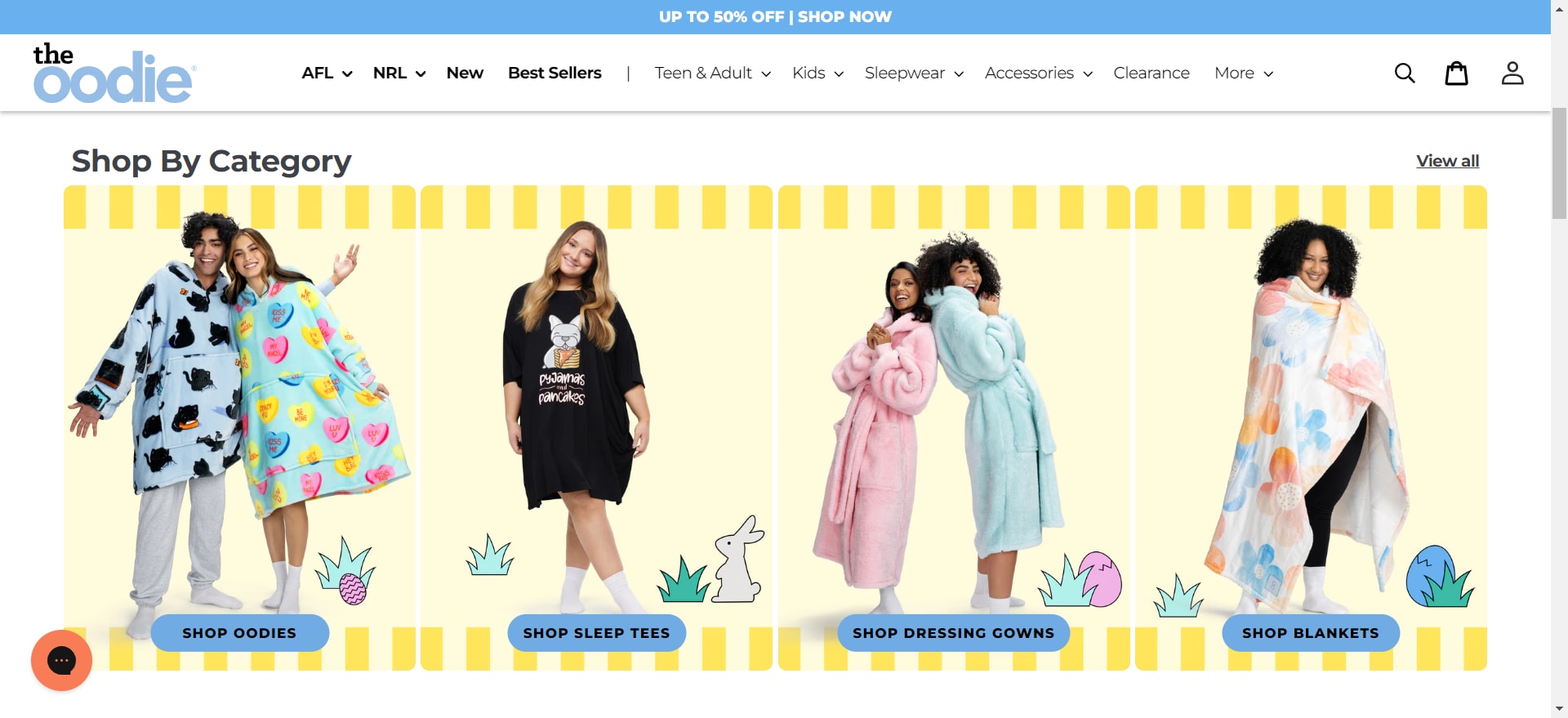
The Oodie online store
What are the top 3 future trends for ecommerce?
What’s shaping the future of ecommerce? Here are our top three picks from different ecommerce trends we’ve seen:
Omnichannel experiences
Customers don't always land on your website directly. They may do a Google search, talk to a friend, or even come across an ad on Instagram. So you need to do a better job at offering a consistent omnichannel experience.
For instance, include features like the following:
Buy online
Pick up in-store
In-store returns for online purchases
Consistent pricing and promotion
Look at your marketing and advertising—not fragmented experiences across multiple platforms. The sooner you do that, the better your outcomes will be.
Product discovery
While purchase history can tell you what a customer wants, tapping into search history tells you more about what they need. Use product discovery tactics to enable this process.
For instance, Constructor lets you use artificial intelligence (AI) to provide accurate and relevant recommendations, increasing the overall order value. Alternatively, use tactics like user-generated content or interactive content to improve product awareness.
Virtual and augmented reality
VR and AR technologies offer immersive experiences using a computer-generated environment that users can interact with. In ecommerce, the applications are limitless. You could help people try out products or see how it works before buying them.

For example, L'Oreal lets you try out hair colors before buying their product so that you're confident with your choice. You can either upload a photo or enable a live try-on. This lets them reduce product returns and improve the customer experience.
Ecommerce businesses are here to stay
Introducing ecommerce transactions has changed the way we do business. From new revenue models to expanded avenues for selling products, the industry has ushered in a lot.
However, starting and scaling a successful ecommerce business can be complex and challenging. So consider hiring freelance experts who have the knowledge and experience to get your brand out there while building solid foundations for success.
Plus, you can scale up and down as needed, allowing you to tap into their expertise only when needed.
Ready to set up your ecommerce business? Sign up for Fiverr today and hire an ecommerce expert.
FAQs
1. What is ecommerce SEO?
Ecommerce SEO (Search Engine Optimization) is the process of optimizing an online store to increase its visibility and ranking on search engine results pages (SERPs) for relevant keywords and phrases.
2. What is ecommerce dropshipping?
Ecommerce dropshipping is an online retail fulfillment method where an online store sells products without keeping the items in stock.
Instead, when a customer orders, the store purchases the item from a third-party supplier, who then ships the product directly to the customer. The online store acts as an intermediary, marketing and selling the products, while the supplier handles the inventory and shipping.
3. What is ecommerce merchandising?
Ecommerce merchandising is strategically displaying and promoting products in an online store to maximize sales and customer engagement. It includes tactics like product placement, pricing, bundling, cross-selling, upselling, and personalized recommendations.
4. What is an ecommerce website?
An ecommerce website is an online platform that allows online businesses to sell products or services directly to customers over the internet. It’s a virtual storefront where customers can browse products, add items to their cart, and complete the checkout process using various payment methods. Walmart is an example of an ecommerce website.
5. What is an ecommerce platform?
An ecommerce platform is a software solution that enables businesses to create, manage, and operate an online store. It gives you the infrastructure to build your store—while you focus on the other aspects. Shopify and Magento are popular ecommerce platforms.
6. What is an ecommerce store?
An ecommerce store, also known as an online store, is a virtual retail outlet that allows customers to purchase products or services over the internet. It is the digital equivalent of a physical store.
7. What is an ecommerce business?
An ecommerce business is a company that conducts commercial transactions over the internet, selling products or services directly to customers through an online store or platform. These businesses can range from small, niche retailers to large, multinational corporations, and can operate in a variety of industries.

